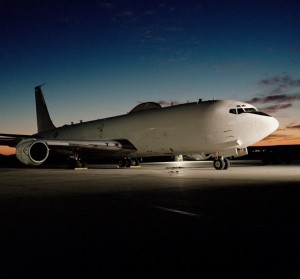Big decision due for doomsday comms
Steve Jobs biographer Walter Isaacson chose the line, “for the loser now will be later to win,” to capture the drama of Jobs, a famous Bob Dylan fan, triumphantly returning to the company he co-founded. By the middle of next year, we’ll find out if that Dylan line might also apply to Raytheon’s satellite communications unit. After losing a competition in 2002, Raytheon is trying to unseat Boeing as the potential supplier for more than $2.3 billion worth of doomsday satellite communications electronics for the president and military commanders.
Boeing beat Raytheon in 2002 for the right to develop the Family of Advanced Beyond Line-of-sight Terminals. Versions of FAB-T would provide comms for the president and commanders aboard the airborne command posts they would seek shelter on in a nuclear crisis. Back in 2002, a production contract was expected to follow no later than 2007. Boeing fell so many years behind schedule that in September 2012 the Air Force hired Raytheon to develop an alternative version to consider for production.
At stake in all this is whether the president and staff will have the kind of highly-personal and high-volume communications they have on the ground. The FAB-T teriminals would be installed on the president’s E-4 “Doomsday” jets and on the military’s E-6B airborne command post planes. The combination of the FAB-T terminals and the military's new Advanced Extremely High Frequency communications satellites would let the president and his commanders do something they can’t do today: Engage in secure video teleconferences over the nation’s most heavily protected satellite communications pathway.
Boeing is running at least five years late on its efforts to perfect its version of FAB-T in hopes of earning a production contract. The Air Force bumped a production decision from 2007 to 2010, then to 2012, and now 2014.
Boeing spokesman Richard Esposito said the technical troubles are behind the project and that all pre-production technical “risks have been eliminated.” The company blames the delays at least in part on design changes ordered for the Advanced EHF satellites during their development. A 2009 Government Accountability Office cited software troubles. Whatever the cause, the Air Force in 2010 began laying the groundwork to inject fresh competition into the FAB-T program.
Threatening to hire an alternative contractor was unusual but not unprecedented. The tactic is typically meant to light a fire under an incumbent. It worked. Boeing last year agreed to shift to a firm-fixed price contract for FAB-T.
Raytheon, though, seems convinced it can be more than a flame under Boeing. In October, it plans to conduct a first over-the-air test with its version of FAB-T. The unit will log onto an Advanced EHF satellite in geosynchronous orbit from Raytheon’s Marlboro, Mass., campus.
“We will demonstrate the FAB-T software running the FAB-T hardware,” said Scott Whatmough, Raytheon’s vice president for integrated communications systems.
A June lab test used electronics adapted from a different terminal Raytheon makes for airmen in charge of Minuteman missiles in their silos. The equipment was plugged into an Advanced EHF satellite simulator to demonstrate a Presidential and National Voice Conferencing capability.
The 2002 defeat was a blow for Raytheon, but far from the end of the company’s EHF work. While Boeing wrestled with FAB-T, Raytheon worked on other EHF projects in the special facility it built in the 1990s on the Marlboro campus.
Raytheon developed Navy Multiband Terminals to connect ships to the Advanced EHF satellites. It added the Advanced EHF signal recipe or waveform to the Army’s rugged Secure Mobile Anti-Jam Reliable Tactical Terminals that ride on the backs of Humvees. Then there was the Minuteman silo version, called MMPU or the Minuteman Minimum Essential Emergency Communications Network Program Upgrade.
Raytheon went to the Air Force with a bold argument that it believed was backed by its record. It said it could rapidly assemble technologies and knowledge from those projects into an alternative version of FAB-T for the E-4s, E-6Bs, plus ground vehicles and command posts.
“We had 80 percent of the FAB-T requirements done and working already in our software baseline,” Whatmough said.
Raytheon has the Air Force’s ear, but Boeing says it does too. It notes that it’s already flown its version of FAB-T on a Boeing 707 from Hanscom Air Force Base, Mass. Raytheon is just now preparing to conduct its first over-the-air test, and that will be from a lab, not an aircraft.
“We are confident that we can finish the program by the first half of next year,” Boeing spokesman Esposito said.
Then we’ll find out whether the loser will be later to win, or whether Boeing will still be the winner.



